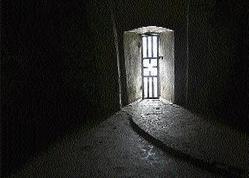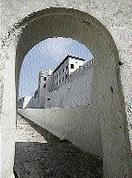

Left: A general view shows 'the door of no return' in Elmina Castle in Cape Coast, Ghana. Right:
A section of Elmina Castle in Cape Coast, Ghana, on Saturday. The castle was used as a trading post for slaves in the 15th century. - Reuters photos
Behind Behind death's door
ELMINA, Ghana (Reuters):
For many, it was their last glimpse of Africa. Pushed through the 'door of no return', millions of Africans were shipped from places like this whitewashed fort in Elmina, Ghana, to a life of slavery in Brazil, the Caribbean and America.
A band of light from that same door now cuts through the air in a small, dank room crowded with about 30 tourists.
"We are very lucky. Today we can go back out of this room the way we came," says Robert Kugbey, their softly spoken guide, recently.
As Britain marked the bicentenary of its abolition of the slave trade on March 25, Ghanaians are still coming to terms with slavery's impact on their country's development and the role Africans played in the capture and sale of fellow Africans.
Picturesque with fishing boats
The view from Elmina, built by the Portuguese in 1482 and later held by the Dutch and the British, is picturesque with fishing boats bobbing in the sea off a white sand beach lined with palm trees.
But Elmina has a brutal history - shared with other slave forts on West Africa's coast, ports in Western Europe and what was then known as the New World, the Americas - in a triangular trade that fuelled Europe's colonial empires.
Sometimes sold into slavery by rival tribes, or captured during communal conflicts, African slaves could face a long forced trek to the coast or weeks in a coastal dungeon before a lengthy sea voyage packed in the hold of a European ship.
Estimates vary widely, but somewhere between 10 and 28 million Africans are believed to have been shipped across the Atlantic between the 15th and 19th centuries.
Many died on the way. Those who survived endured a life of drudgery on sugar, tobacco and cotton plantations.
At modern-day Elmina, the ocean thrashes under a clear blue sky, the breeze blows and in the air of what was once the governor's chambers, Kugbey tells a rapt audience stories that never lose their power to horrify, no matter how often told.
Stepping on to his balcony in the evening, the governor would choose a female slave from the yard below, he said.
"Any time he wanted to rape one of the slaves, he looked through and picked one," Kugbey said.
About 150 of the castle's 1,000 inhabitants, of which 400 were women, lived in this dungeon, the only ventilation provided by a single porthole.
Once covered with faeces, vomit, urine and menstrual blood, today the stone floor is quiet but for the tourists' shuffling feet.
"When they died they were thrown into the sea. They said if they gave them good food, they would fight. Some refused to eat, they preferred to die," said Kugbey.
On the fort's upper floors, above the bodies in chains, the governor and his soldiers prayed in a chapel.
"After buying and selling human beings, they came here and prayed to God. Where was God at that time?" asked Kugbey.
Some people say the loss of generations of men and women to slavery is partly to blame for the economic problems and slow development of modern Africa.
Yet Africans, too, played a role in slavery, a trade which existed before the arrival of the Europeans.
Even today, Ghanaian children are trafficked to fishermen, sold by their poverty-stricken parents into a form of modern slavery, Kugbey added.
For the British tourists who make it here, Elmina is a reminder of a time when the British empire stretched far and wide: fuelled by trade, colonial ambition and exploitation.
"We felt we had to come, it is part of the history we share, not a pleasant part of our history," said Anne Wilkins, a British teacher on a short exchange with a Ghanaian school.
"It is important to come as it helps put things to rest. It is horrible to think people were treated in this way."

